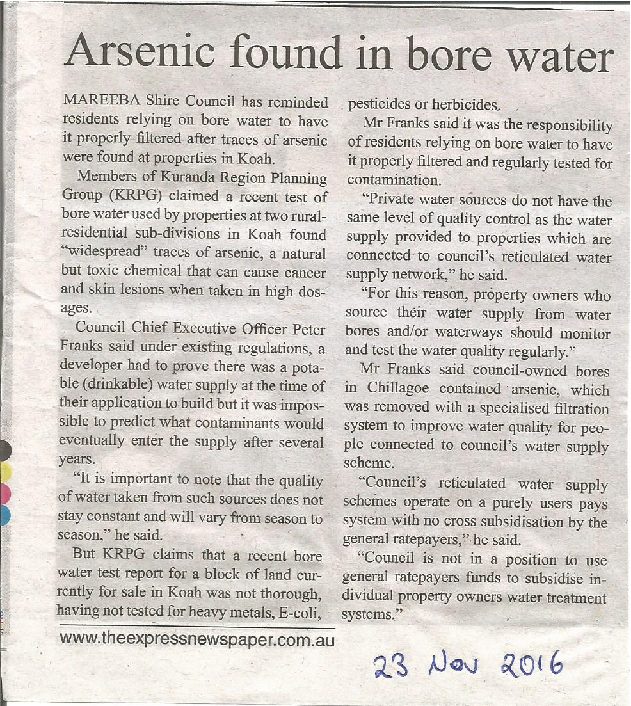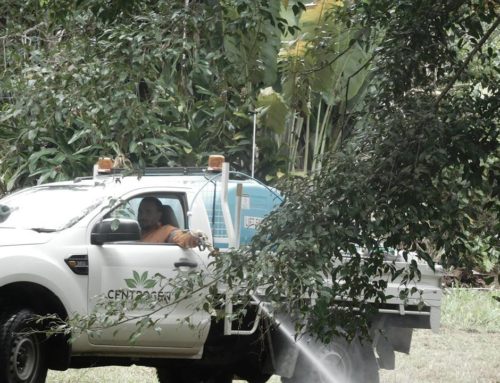Council approved rural residential subdivisions in Koah which were subject to potable water have above safe Australian Drinking Water Guideline levels of Arsenic in bore water.
A community project tested bores for heavy metals using ALS laboratories the same reputable lab Mareeba Shire Council uses.
There seems to be a widespread presence of Arsenic in the shire.
Even though Australian safe drinking water guideline levels are set at 0.01 mg/l, it is a purely practical number. The US EPA drinking water guideline states there are no safe levels for arsenic and lead apart from zero.
In recent rural residential subdivisions in Koah with blocks still up for sale Arsenic levels are above safe Australian Drinking Water Guideline levels.
As the CEO said at the Koah community BBQ, a council condition for those subdivisions is to provide potable water.
Surely that means water free from arsenic. We have managed to get our hands on a bore report for one of the blocks still for sale.
The test did not include heavy metals, e-coli, pesticides or herbicides (the area is of course a farming area) – yet the real estate person claimed it is beautiful drinking water. A different real estate agency did the same.
An unknown number of properties might not have safe water to use when they were told otherwise.
It is common that people share the same water table so it is probable that more bores have above safe levels of arsenic in their water.
Surely it would be best if all bores were retested to include arsenic, other heavy metals, E.coli, pesticides and herbicides so that residents can’t unknowingly get poisoned.
Compensation for property owners who have now no potable water should be considered as the value of real estate will be seriously affected by this.
As council knows Arsenic seems to rear its head all over the shire with Chillagoe’s untreated town water drawn from bores exceeding criteria five times out of six.
We also found elevated levels in Kuranda, Cardinia Estate and Davies Creek fish farm along Kenedy Highway.
In view of this council should demand more comprehensive bore-water testing to ensure potability of bores in the shire.
Last December a heavy metal test of the beautiful Clohesy River also revealed elevated levels of Arsenic, Cadmium and Lead.
Though levels were within the safe range that time, there is no knowing what levels are at other times in an forever changing water source.
Council recommended in an old correspondence from 2012:
Council does not advise residents of the region on how to manage this risk other than to say that for human consumption, residents must be mindful of the risks inherent in untreated water supplies.
…… is worried about heavy metals in the Clohesy River. I suggest she not drink or cook with water from the river as the likelihood of biological infection is always present even if there were no heavy metals detected in the various low cost test kits available.
In view of this it seems surprising council is approving subdivisions in Koah with the condition that the Clohesy River should supply the potable water.
|
|
|
|
|
|
|
|
|
Senior Planner
Dear Brian
Thank you for your reply.
As residents health and safety is at stake Council should inform residents who were promised potable water that they might not have any unless their water underwent comprehensive testing and the test results prove it.
And where residents have now no potable water Council should consider compensation as it neglected to make certain of it when the applicant/developer had to demonstrate that any source of potable water supply can satisfy the standards for drinking water set by the Australian Drinking Water Guidelines 2004.
We realize Council is not generally responsible for bore water quality.
However when the planning department makes a subdivision approval subject to potable water surely this must mean drinkable water not amount of water.
The matter came up in the Koah community BBQ as we had received the first bore water results that day.
Both the CEO and Nipper Brown said in front of a big audience that rural residential subdivisions were subject to having water. When asked if that was only quantity they said no it is both.
In fact the following seems to be a standard condition for example found in DA/16/0005 1 lot into 2 in Koah approved against planners recommendation as per Council minutes 02 March 2016.
DA/16/0009 reconfiguration of lot 1 into 4 or DA/15/0056 1 lot into 2 both in Koah as per Council agenda 01 June 2016:
4.4 Non-reticulated Water Supply
4.4.1 Each Lot must be provided with a potable water supply via bore or by water rights to a perennial stream in accordance with Planning Scheme Policy No. 1 – Water Supply (Outside Reticulated Water Supply Area).
4.4.2 Where a bore is to be used as a source of water, bore installation will be in accordance with the requirements of D6.07 of the FNQROC Development Manual.
4.4.3 Where a bore is to be used as a source of potable water, it will be sited in accordance with the setback distances specified in the Queensland Plumbing and Wastewater Code.
4.4.4 The applicant/developer must demonstrate that any source of potable water supply can satisfy the standards for drinking water set by the Australian Drinking Water Guidelines 2004 (National Health and Medical Research Council and the National Resource Management Ministerial Council).
4.4.5 Rainwater tanks will not be accepted as a means of potable water supply for either allotment.
4.4.6 If an existing bore is proposed as a potable water supply for any lot, this bore must comply with 4.4.2 (minimum sustainable yield only), 4.4.3 and 4.4.4 above.
The following segment from the 2004 MSC planning scheme also says:
PART 8 –
PLANNING SCHEME POLICIES
PLANNING SCHEME POLICY 1 Water Supply (Outside Reticulated Water Supply Area)
APPLICABILITY
This Policy applies to development within the Shire and sets down the requirement for subdivision of land not connected to a reticulated water supply and outside the reticulated water supply areas, as delineated on Maps CGO_Water, DIM_Water, MOL_Water, KUR_Water, MBA_Water.
Statement
Before the survey plan for the subdivision of land is signed and sealed by Council, each allotment created has an adequate water supply, either by water rights to a perennial stream, chemically suitable for human consumption, in accordance with standards required by the National Health and Research Council’s guidelines for Drinking Water Quality in Australia, or via water bore constructed to the following standards:
(i) A water bore shall be constructed on each proposed lot.
(ii) The bores must produce a sustainable yield of no less than one (1) litre per second, as determined by a four (4) hour pump test in accordance with AS2368-1990 “Test Pumping of Water Wells” and pump test analysis, including observations of potential interference between bores, by a person qualified in groundwater hydrology.
(iii) Water samples shall be collected from the bores in accordance with AS2368-1990 and analysed by a NATA registered laboratory or other laboratory as approved by Council. Water must be chemically suitable for human consumption in accordance with the “Australian Drinking Water Guidelines” issued by the National Health and Medical Research Council.
(iv) The casement of the bores shall not exceed 125mm in diameter.
(v) The placement of the bores shall be determined by a qualified person satisfactory to Council in conjunction with the placement of any wastewater disposal system to be used on the allotment.
(vi) The bore holes shall be cased and sealed at its surface to prevent the inflow of contaminated surface water to the satisfaction of Council’s Plumbing Inspector.
(vii) The bores shall be sunk to a minimum depth of 60 metres, or until the bore reaches bedrock.
We find this matter confusing as we are receiving conflicting information from Council.
Your Kuranda Region Planning Group





